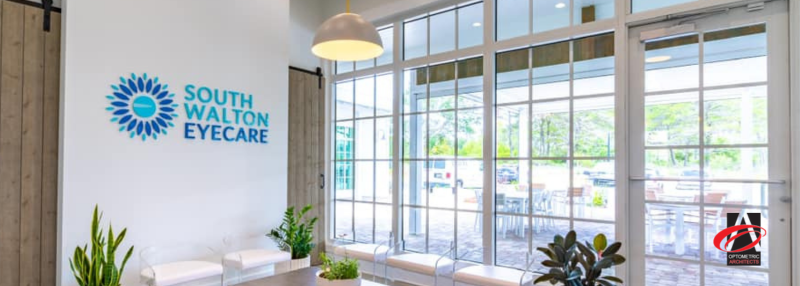Posted On: December 24, 2024 by Optometric Architects in: Interior Design

As an eye care professional, you understand the significance of creating a comfortable and functional environment for your patients. One often overlooked aspect of eye clinic design is lighting, which plays a crucial role in enhancing the overall patient experience and improving clinical outcomes. So, let’s explore why lighting matters in eye clinic design and provide essential considerations for creating an optimal lighting plan.
Why Lighting Matters in Eye Clinic Design
Patient Comfort and Anxiety
A well-designed lighting system can significantly impact patient comfort and anxiety levels. A study by the American Academy of Ophthalmology found that several factors influence a patient’s intraoperative experience – confidence, pain perception, comprehension, memory, reassurance, and satisfaction.1 By incorporating soothing lighting elements, such as warm-toned LED lights or natural light, you can create a calming atmosphere that puts patients at ease and more confident in their surroundings.
Visual Acuity and Accurate Diagnosis
Proper lighting is essential for accurate diagnosis and treatment. Inadequate lighting can lead to misdiagnosis, compromised patient care, and even malpractice claims. A study published in the Indian Journal of Journal of Ophthalmology emphasized “the significant impact of both central and peripheral luminance on visual acuity.”2
Staff Productivity and Efficiency
Adequate lighting also boosts staff productivity and efficiency. Well-lit workspaces reduce eye strain, allowing staff to focus on providing exceptional patient care. In fact, a study found that improved lighting can increase productivity by up to 15%.3
As we age, our eyes undergo natural changes that affect our ability to see clearly. To compensate, older employees benefit from tailored lighting solutions that cater to their unique needs. Specifically, higher illumination levels (around 500-750 lux), reduced glare, and warmer color temperatures (2700-3000K)3 can make a significant difference. Additionally, task lighting can help compensate for reduced contrast sensitivity and visual acuity, which can be particularly challenging for older workers.
By making these adjustments, you can enhance visual performance by up to 20% for older workers,3 leading to improved comfort, productivity, and overall job satisfaction. The American Optometric Association (AOA) recommends these adjustments to help mitigate age-related vision decline, ensuring that everyone, regardless of age, can work comfortably and effectively.3 By recognizing and addressing the changing lighting needs of older employees, you can create a more inclusive and supportive work environment that fosters success and well-being.
Key Considerations for Lighting in Eye Clinic Design
1. Layered Lighting
Implement a layered lighting approach, combining ambient, task, and accent lighting to create a flexible and functional lighting system.
2. Color Temperature and Intensity
Select lighting with a color temperature between 3500K and 4100K, which is gentle on the eyes and promotes visual comfort. Adjust intensity levels to suit different areas of the clinic, such as exam rooms and waiting areas.
3. Natural Light Integration
Incorporate natural light wherever possible, using skylights, windows, or solar tubes to reduce the need for artificial lighting and promote a sense of well-being.
4. Glare Reduction
Minimize glare from lighting fixtures, computers, and other equipment to prevent eye strain and discomfort.
5. Energy Efficiency
Choose energy-efficient lighting options, such as LED or induction lighting, to reduce energy consumption and lower operating costs.
6. Adaptability and Flexibility
Design a lighting system that can adapt to different clinical scenarios, such as adjusting brightness levels for patients with sensitivity to light.
7. Infection Control
Select lighting fixtures that are easy to clean and maintain, reducing the risk of infection transmission.
Final Thoughts
Lighting is a critical component of eye clinic design, influencing patient comfort, visual acuity, and staff productivity. By considering the key factors outlined above, you can create an optimal lighting plan that enhances the overall patient experience and supports exceptional eye care.
At Optometric Architects, we specialize in designing eye clinics that prioritize patient comfort, clinical efficiency, and visual acuity. Contact us to learn more about our expert design services and how we can help you create a state-of-the-art eye clinic.
References
1 Reducing Patient Anxiety During Surgery - American Academy of Ophthalmology
2 Indian Journal of Ophthalmology
3 How Lighting Ergonomics Boosts Employee Productivity and Wellbeing | BenQ US


0 comments